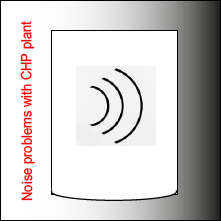
Combined heat and power (CHP) is used to generate electricity and provide heat as a waste product. An energy efficiency of over 90% is predicted by the vendor. The electricity-generating engine is fueled primarily by gas. The issue: larger biogas-plants are mostly in massive buildings at a distance of more than 500 meters to the nearest residential area. Smaller plants move ever closer to the vulnerable housing and are housed in part only thirty meters away. Micro-CHP will be even in the basement of homes, schools, hotels and commercial facilities.
The sound problem with a combined heat power plant is barely discussed
The soundproofing problem is mentioned in the brochures of the manufacturers barely. There is simply a reference that the plants are soundproofed. The expert knows that sound is not the same sound. Problems make especially low tones which are in the frequency range below 100 hertz. According to the usual sound assessment with the so-called A-levels low tones don‘t stand out and the manufacturer seems specious “off the hook”. The press has repeatedly reported that the softly humming can drive the people to the brink of insanity.
How is the sound problem being solved ?
By enclosing the motors and installation of silencers for low-frequency tones, the manufacturer may contribute to its maximum noise control. When installing, make sure that full decoupling of pipelines and power cables from the building is achieved. The building itself should have high attenuation values. Lowest execution errors can lead to noise problems. If is specified as a installation goal, that the system should be “inaudible”, the project should fail.
Conclusion of sound discussion
CHP units within buildings carry a high risk of noise. CHP therefore should at least not be scheduled directly below living spaces, but laterally offset or better yet, in a massive outbuilding.
